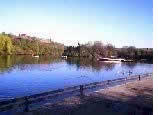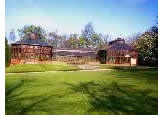Stalybridge
Stalybridge Town Centre
Services in Stalybridge
Tameside Image Archive
Take a look at the historical images of Tameside we have available.
Huddersfield Narrow Canal Restoration
Find out more about the restoration of the Huddersfield narrow canal.
Coat of Arms
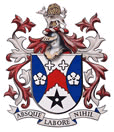 Argent, a chevron engrailed gules between two crosses pointed voided in chief sable and a mullet in base also sable and pierced of the field, with two flanches azure each charged with a cinquefoil of the field. Crest: On a wreath of the colours, A garb Or, in front thereof a wolf statant argent. Motto: Absque labore nihil. Granted: 18 June 1857.
Argent, a chevron engrailed gules between two crosses pointed voided in chief sable and a mullet in base also sable and pierced of the field, with two flanches azure each charged with a cinquefoil of the field. Crest: On a wreath of the colours, A garb Or, in front thereof a wolf statant argent. Motto: Absque labore nihil. Granted: 18 June 1857.
The shield comprise the arms of the town's previous landowners, the Stayleys, the Asshetons, and the allied Dukinfields and Astleys, together with the golden wheatsheaf of Cheshire and the silver wolf of Chester. The motto proclaims the philosophy of the modern industrial town 'Nothing without Labour.
History of Stalybridge
Early History
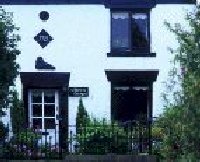 The name Stalybridge derives from 'Staef' - a stave - and 'leah' - a clearing in the wood, the full meaning of 'Staley' being 'a wood where staves are collected'. The 'bridge' was added in the early 19th century. Prior to 1750, the population of Stalybridge was sparse. Between 1700-1750 the villagers numbered no more than 140 at any one time, earning a living in a dual capacity as farmers and weavers. They lived in cottages such as those still existing at 'Bohemia', constructed in 1721. Some of them would have had loom-house attached where as many as six to eight spinners worked to supply one weaver.
The name Stalybridge derives from 'Staef' - a stave - and 'leah' - a clearing in the wood, the full meaning of 'Staley' being 'a wood where staves are collected'. The 'bridge' was added in the early 19th century. Prior to 1750, the population of Stalybridge was sparse. Between 1700-1750 the villagers numbered no more than 140 at any one time, earning a living in a dual capacity as farmers and weavers. They lived in cottages such as those still existing at 'Bohemia', constructed in 1721. Some of them would have had loom-house attached where as many as six to eight spinners worked to supply one weaver.By 1750 there were already a few, small woollen mills in Stalybridge, based along the river to take advantage of the ready supply of water-power. The first cotton mill was erected by Edward Hall, whose mill in Wood Street was also the first to acquire a steam engine, in 1796, together with a chimney to carry away the smoke, which earned it the nickname of the 'Soot-Poke Mill'. These chimneys soon became a dominant feature of the landscape as Hall was followed by other cotton pioneers such as John Cheetham (1802 - 1886) the great cotton master and reformer, and Abel Harrison (1793 - 1865) who bought the Staley Mills, and built Highfield House, whose grounds make up the present Stamford Park.
Industrialisation
The impact of industrialisation led to a rapid increase in the town's population which rose in the years 1823-1825 from 5,500 to 9,000 and, by 1851, had reached an immense 20,760. In 1828, the Stalybridge Police and Market Act made Stalybridge an independent town, with a board of commissioners; the Stalybridge Gas Company was formed and given the contract for lighting the town, and three years later, the Town Hall and Market were officially opened on December 30, 1831. The town was made a borough on March 5, 1857.Social Unrest
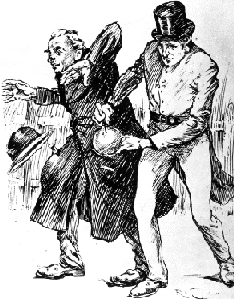 William Chadwick, in his 'Reminiscences of a Chief Constable' declared: "The people of Stalybridge have immortalised themselves in the way of strikes, or turnouts."
William Chadwick, in his 'Reminiscences of a Chief Constable' declared: "The people of Stalybridge have immortalised themselves in the way of strikes, or turnouts."As early as 1817, an association later known as the 'Blanketeers' arose with the aim of marching to London to lay the grievances of the people before the government. It was a Stalybridge band which was engaged to play at Peterloo in 1819 and the Chartist sympathiser JR Stephens found a great many supporters in the town for his liberal ideas. There were riots in the town in 1842 when attempts were made by the mill-owners to reduce their operatives' wages to combat a slight depression in the trade.
These riots had to be dealt with by volunteers but, by the 1830s, Stalybridge had two full-time policemen and a number of special constables, known as 'Old Charlies'. In 1857 Stalybridge acquired a Borough Police Force of which William Chadwick became Chief Constable in February 1862. Born at Mottram on July 24, 1822, Chadwick had joined the London police force at the age of 29 and was later stationed at Dukinfield. He was promoted to Inspector at Ashton-under-Lyne and held the record for conviction of criminals there when he left for Stalybridge where he was to be Chief Constable for 37 years. During this time there were again serious riots in the town; in 1863 when unemployment caused by the cotton famine was rife and the Relief Committee attempted to supply the destitute with vouchers instead of money, and again in 1868 when the anti-catholic 'Murphy Riots' broke out. The police were aided by the military in subduing these outbreaks.
Despite the Cotton Famine of the 1860s, there were steady improvements in the social conditions of the town. The Mechanics' Institute, formed in 1825, moved to new and larger premises in the High Street in July 1862. The first School Board was elected in Stalybridge in 1871 and the first public park opened by Lord Stamford in 1873. Since 1867 Stalybridge had had the right to return an MP to Westminster. Her first representative was James Sidebottom JP and one of his most distinguished successors was John Frederick Cheetham whose family owned Bankwood Mills and Eastwood House, since demolished, the grounds of which now form Cheethams Park. In 1880 he was elected MP for North Derbyshire and in 1905 and 1906 was returned for Stalybridge.
A public library service had been opened in the town on September 21, 1889, but was soon seen to be outgrowing its accommodation. J.F. Cheetham offered to build, equip and present to the town a new building, large enough to provide future development and, in collaboration with the architect J Medland Taylor, he planned the Astley Cheetham Public Library. Mrs. Astley Cheetham laid the foundation stone on October 9, 1897, and beneath the stone were placed copies of local newspapers and coins. The new library was officially opened on October 16, 1901, when Mrs Astley Cheetham was presented with a gold key. Her husband continued to make generous donations to the upkeep of the library. He also presented his art collection to the town which is housed in the Astley Cheetham Library.
The Twentieth Century
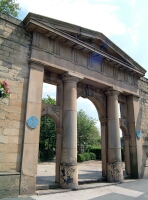
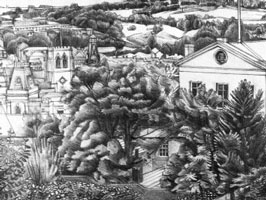 In 1901 an Act of Parliament set up the Joint Electricity and Tramways Board for Stalybridge, Hyde, Mossley and Dukinfield, and the first electric train ran from Stalybridge to Hyde in 1904. The electric works in the Tame Valley were replaced in 1926 by the Hartshead Power Station.
In 1901 an Act of Parliament set up the Joint Electricity and Tramways Board for Stalybridge, Hyde, Mossley and Dukinfield, and the first electric train ran from Stalybridge to Hyde in 1904. The electric works in the Tame Valley were replaced in 1926 by the Hartshead Power Station.The character of Stalybridge altered over the 20th century. At the turn of the century the cotton industry was still strong and the population of the town reached its peak in 1901, at 27,623, but as trade dwindled the population began to decline and, despite the intensified employment of the war years, the main industry of Stalybridge continued to fail. By 1932, seven of the town's largest mills had closed and unemployment reached 7,000. In 1934 an Industrial Development Committee was set up to encourage new industries to settle in the town. New housing estates were built to replace the slums and, gradually, redundant mills were occupied by firms in the various light industries. New applications of engineering principles, the manufacture of rubber goods, plastics, chemicals and packaging materials were all introduced, as well as the addition of synthetic fibres to the textile trade. Unemployment declined and, for the first time since 1901, there was an increase in the population of Stalybridge. In 1991 it was 22,295.
Facts About Stalybridge
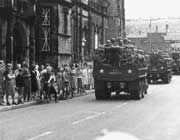
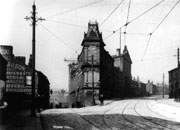
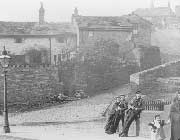
A comprehensive selection of historical photographs can be found at www.tameside.gov.uk/history
- Stalybridge has two known entries in the Guinness Book of Records for 1995 - the pubs with the longest and shortest names in the United Kingdom! The longest named is: "The Old Thirteenth Cheshire Astley Volunteer Rifleman Corps Inn", on Astley Street, and the shortest is: The "Q" Inn, on Market Street!
- Stalybridge Station Buffet Bar dates back to 1885. It retains many of its original features, and travellers and townspeople alike can still enjoy a pint or a cup of tea there, surrounded by mementos of an earlier time, and watched over by the image of Queen Victoria etched in the glass of the great mirror that hangs over the fire!
- Jack Judge (1878-1938) was a fishmonger from Oldbury in Staffordshire who became a singer-comedian after winning a talent competition. Jack is best remembered as the writer and composer of the song "It's a Long Way to Tipperary" which became immensely popular during the First World War. This was written in Stalybridge on 30th January 1912, as the result of a five shilling bet, and was first performed on the following day at the Grand Theatre in the town!
- Ada Jane Summers (1861-1944) was the first woman councillor in Tameside, the first woman councillor, mayor and freeman of Stalybridge, and one of the first women in England to be appointed a justice of the peace!
- Stalybridge Brass Band is the oldest brass band in the world.
- Stalybridge is home to 2 Grade II* and 53 Grade II Listed Buildings.
- Blue Plaques denote areas of historic interest - Stalybridge is the proud home to 16 of 63 plaques within the Borough.
- The 1979 film "Yanks" which starred Richard Gere dealt with the invasion of hundreds of American soldiers during World War II - and was filmed in part in Stalybridge.
- Sited on the front of Stalybridge Library in Trinity Street, Stalybridge, a blue plaque honours Sergeant William Booth who served in the 20th Manchester Regiment in Italy during the First World War.
- John Bradbury was a truly remarkable man - celebrated botanist, intrepid explorer of the interior of America, author and family man. John Bradbury's Blue Plaque is located at Stalybridge Country Park.
- Born in May 1813 at Cocker Hill in Stalybridge, John Buckley was destined to have a tragic family life though he himself thwarted death many times. His blue plaque is located at the Travellers Call Public House, Stalybridge.
- A blue plaque on Stalybridge Town Hall frontage commemorates the first general strike which originated in this area.
- A plaque to our local dialect poet, Samuel Laycock is on a stone plinth on the site of the Mechanics Institute on the High Street in Stalybridge (now moved to Hob Hill Mews).
- Gibbon Mitchell was born in 1869 in a house built by his stonemason father on Malakoff Street, Stalybridge. His blue plaque is situated at Malakoff Street, Stalybridge.
- Robert Platt (1802-1882), born in Stalybridge, and Margaret Platt (1819-1888), born in Salford, were philanthropists and benefactors of "The Public Baths", Stalybridge opened in May 1870. Their blue plaque is located at Woodlands, Mottram Road, Stalybridge.
- The Blue Plaque at Gorse Hall Estate, Stalybridge, celebrates the site of Gorse Hall which was built by Beatrix Potter's maternal grandparents, John and Jane Leech. Beatrix often visited Gorse Hall with her mother, Helen Leech.
- Sited at the National Railway Museum, York, the plaque commemorates the fully restored original station clock, now entrusted to the museum, with a replica clock at Stalybridge Station.
- The work of the committed reformer, Joseph Raynor Stephens who strove to protect the workers from the worst excesses of industrialisation and who had such a strong impact locally. His blue plaque is situated at Stalybridge Town Hall Frontage, Waterloo Road.
- Twenty years the junior of John Bradbury was one Jethro Tinker who also became a well known botanist, particularly in the vicinity of Stalybridge where he lived all his eighty three years. Jethro Tinker's Blue Plaque is located at Stalybridge Country Park.
- The blue plaque located on the Buffet Bar at Stalybridge Station was unveiled on 15th March 2002 by Mrs. Ellen Bate, as a tribute to her father, Fred Wood.
Places of Interest in Stalybridge
 Eastwood Educational Nature Reserve, Stalybridge
Eastwood Educational Nature Reserve, Stalybridge
A cut-over, lowland, raised mire SSSI, surrounded by a woodland fringe. Characteristic bog plants include sphagnum mosses, cotton grass and cross-leaved heath. 9 species of dragonfly and damselfly have been recorded on the reserve along with the green hairstreak butterfly.Cheshire Wildlife Trust
 Cheshire Wildlife Trust, Grebe House, Reaseheath, Nantwich, Cheshire, CW5 6DG
Cheshire Wildlife Trust, Grebe House, Reaseheath, Nantwich, Cheshire, CW5 6DG 01270 610 180
01270 610 180  01270 610 430
01270 610 430  info@cheshirewt.cix.co.uk
info@cheshirewt.cix.co.uk
 Astley Cheetham Art Gallery
Astley Cheetham Art Gallery
The Gallery was built as a gift to the town of Stalybridge in 1901. The Library houses the largest collection in Tameside of books, records, documents and maps for the study of the area's history and family ancestry. A wide range of publications are for sale.
Stamford Park and Boating Lake
The Park was opened in July 1873. At first the Park was managed by trustees but was handed over to the two town councils of Stalybridge and Ashton in 1891. Stamford Park was greatly enlarged in 1892 and the boating lake was formed. Take a trip on the boating lake, stroll around the park and the dingle, have a game of crazy golf, visit the arboretum, let the children feed the ducks at the duck pond, or just paddle in the paddling pool! A great day out for all the family!
Please:
- Keep to Paths
- No Dogs
- No Cycling


